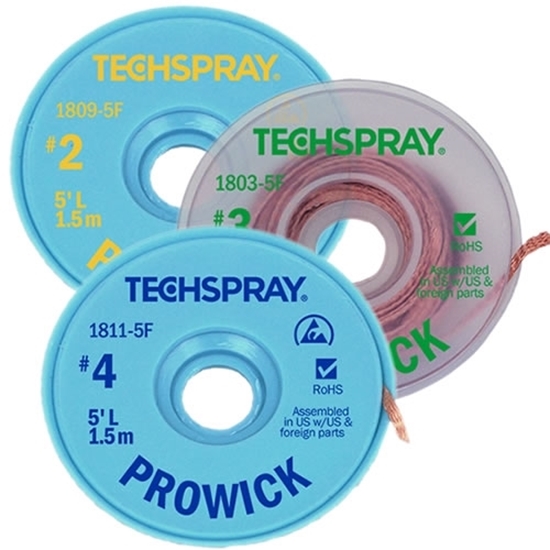
자주 묻는 질문
Techspray는 2가지 타입의 플럭스를 사용합니다. Prowick 라인은 천연 검 로진입니다. J-STD-004 절 3.2에 따라 Prowick는 ROL0로 분류되었습니다. British Std. EN 29454-1:1993 및 ISO9454-1:1990에 따라 Prowick는 1.1.1.B로 분류됩니다. No-Clean 플럭스는 합성 (non-colophony) 플럭스입니다. J-STD-004 절 3.2에 따라, REL0으로 분류됩니다. British Std. EN 29454-1:1993 및 ISO9454-1:1990에 따라 No-Clean 플럭스는 1.2.3.B로 분류됩니다.
Techspray 디소더 브레이드 (윅)과 땜납 인두만 있으면 됩니다. 기본 설명은 다음과 같습니다. 1) 땜납 표면 영역과 브레이드 접촉을 최대화하도록 불필요하게 땜납이 가장 많이 쌓인 부위에 브레이드를 놓습니다. 2) 그 다음에 인두 팁을 45도로 윅에 올려 놓고 패드로 열이 전달되게 합니다. 용해된 땜납은 브레이드에 흡수됩니다. 3) 솔더 팁과 브레이드를 필요한 만큼 움직여서 한 번에 모든 땜납을 제거합니다. 긁힐 수 있으니 패드 위에서 브레이드가 끌리지 않게 주의합니다. 4) 브레이드에 땜납이 가득차면 깨끗한 부분을 남기고 일부를 다듬습니다. 기판에 와이어가 납땜되는 것을 방지하려면 인두와 브레이드를 동시에 제거합니다.
예, 필요한건 Techspray 디소더 브레이드 (윅)과 납땜 인두입니다. 기본 설명은 다음과 같습니다. 1) 땜납 표면 영역과 브레이드 접촉을 최대화하도록 불필요하게 땜납이 가장 많이 쌓인 부위에 브레이드를 놓습니다. 2) 그 다음에 인두 팁을 45도로 윅에 올려 놓고 패드로 열이 전달되게 합니다. 용해된 땜납은 브레이드에 흡수됩니다. 3) 솔더 팁과 브레이드를 필요한 만큼 움직여서 한 번에 모든 땜납을 제거합니다. 긁힐 수 있으니 패드 위에서 브레이드가 끌리지 않게 주의합니다. 4) 브레이드에 땜납이 가득차면 깨끗한 부분을 남기고 일부를 다듬습니다. 기판에 와이어가 납땜되는 것을 방지하려면 인두와 브레이드를 동시에 제거합니다.
디소더 브레이드는 세척 과정과 기타 요건에 따라 다양한 플럭스 타입이 있습니다. 1) 로진 - 로진 플럭스드 브레이드는 가장 신속하게 위킹 작용을 하지만 완전히 제거해야 하는 잔여물이 남습니다. 2) No-Clean - No-clean 플럭스드 브레이드는 세척이 가능하지 않을 때 이상적입니다. 땜납 제거 후 투명한 비이온성 잔여물이 남습니다. 현장 작업의 경우 철저한 세척이 더 문제가 되며, 이 타입의 브레이드를 사용합니다. 3) 언플럭스드 - 플럭스가 지정되고 변경할 수 없는 생산 또는 수리 환경에서 또는 수성 플럭스가 필요할 때 이 타입의 브레이드에 플럭스를 추가할 수 있습니다. 플럭스를 추가하지 않는 한 언플럭스드 윅으로 땜납이 제거되지 않습니다. 플럭싱 브레이드에 매우 적합한 여러 타입의 플럭스는 펜 포장이 됩니다.
디소더 브레이드 또는 "윅"은 땜납을 제거하기 위한 프리플럭스드 구리 브레이드로서 구성품을 교체하고, 과잉 땜납 (예: 브리징)을 제거할 수 있습니다. 납땜 인두를 땜납 이음부에 놓인 윅에 사용한 후, 둘 다 땜납 용해점에 도달하면 플럭스가 활성화되며, 브레이드 설계에 의한 모세관 작용을 통해 땜납이 윅으로 흡수됩니다. Techspray 윅은 30년 이상 PCB 재작업, 수리 및 시제품화 스테이션에서 중심을 차지해왔습니다.
제품 유통기한은 제품 페이지에 있는 기술 데이터 시트(TDS) 또는 적합성 증명서(COC)롤 살펴 보시면 알아볼 수 있습니다. https://www.techspray.com/coc로 이동하여 COC를 다운로드할 수 있습니다. 유통기한을 확인했으면 사용기한의 제조 날짜에 추가해야 합니다. 제조 날짜는 배치 번호로 식별할 수 있습니다. 대부분의 자사 제품의 배치 코드는 Julian Date 형식의 제조 날짜입니다. 이 형식은 YYDDD이며, YY = 연도, DDD = 날짜입니다. 예를 들어, 19200은 2019년 200일 또는 2019년 7월 19일입니다. 배치 번호에 대한 이해를 돕기 위해 이 웹페이지에 설명하고 차트를 제공하였습니다 : https://www.techspray.com/batch-codes.
예, 납땜이 완료된 후 인쇄 회로 기판(PCB)에서 로진 플럭스를 제거해야 합니다. 다음은 플럭스 잔여물을 제거하는 이유입니다. PCB 외관 개선 - PCB 계약 제조자인 경우 기판 외관은 자신의 작업을 반영합니다. 땜납 이음부 주변에 기름기 같은 잔여물이 있으면 고객이 QC 검사관 도입을 시도할 수 있습니다. 플럭스 잔여물이 탄화되어 땜납 이음부 위에 스폿을 형성하면 땜납 이음부의 빈 공간 또는 ""블로우 홀""과 같은 결함으로 보일 수 있습니다. 재작업으로 인한 플럭스 잔여물인 경우 재작업 영역의 결함 태그 역할을 하게 되어 문제가 되지 않다라도 주의를 불러일으키게 됩니다. PCB 신뢰성 개선 - 신뢰성 요건은 최종 제품 특성과 보통 관련이 있습니다. 컴퓨터 키보드와 같은 일회용 제품의 경우 작동이 멈추더라도 인명 피해가 없습니다. 이 경우, EMS 공급자는 no-clean 플럭스를 사용하고, 세척 과정을 단념할 수 있습니다. 반면에, 사망과 직접 관련이 있는 심장 박동기 전자장치 요건은 훨씬 더 엄격해집니다. 이 예에서 조립과 재작업 후에 세척이 필요해지고, 이 과정의 효과성과 반복성에 대해 철저히 시험하게 됩니다. 긴 수명의 내구성의 제품은 엄격한 시험과 관리 없이 세척 요건이 있을 수 있습니다. 구성품과 PCB의 부식 방지 - 전자 회로 기판에 남은 플럭스 잔여물은 산성입니다. 세척 과정으로 제거하지 않으면 주위 공기 중의 수분을 흡수해서 구성품 리드와 PCB 접촉장치에 부식을 일으킬 수 있습니다. 컨포멀 코팅 관련 접착 문제 방지 - 대부분의 사람들은 페인트 칠을 할 때 완전히 깨끗하게 표면을 처리해야 한다는 것을 알고 있습니다. 그렇지 않으면 페인트가 표면에서 금방 벗겨지게 됩니다. 동일한 논리는 no-clean 플럭스로 인한 오염이더라도 컨포멀 코팅에도 해당됩니다. ""No-clean""은 납땜 후 남은 이온성 물질의 양을 가리킵니다. 코팅이 부착된 여부와 관계가 없습니다. 코팅하기 전에 PCB에 플럭스 잔여물이 남아 있는 경우 코팅이 들리거나 기판 표면에서 얇은 조각으로 갈리지게 되는 것이 일반적입니다. 이것은 전체 표면이 아닌 땜납 이음부 주변에서 포켓이 분리될 때 특히 그렇습니다 (웨이브 납땜 PCB 하부는 제외). 설상가상으로 코팅은 보통 반투과성이므로 어느 정도는 통기성이 있습니다. 수분이 들어가고 플럭스 잔여물을 적셔서 부식에 이를 수 있습니다. 이온성 오염으로 인한 수상 돌기 형성 방지 - 주위 공기의 수분에 노출될 때와 전류가 가해질 때 플럭스 잔여물과 기타 원인으로 인한 극성 또는 이온성 입자는 수상돌기와 같은 체인 또는 가지 모양으로 연결될 수 있습니다. 이 수상돌기는 전도성이므로 전류 누설을 일으키거나 시간이 더 지나면서 단락을 일으키는 트레이스를 형성합니다.



